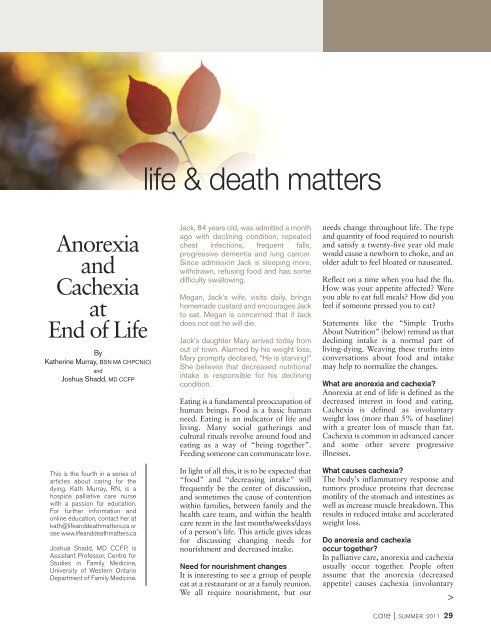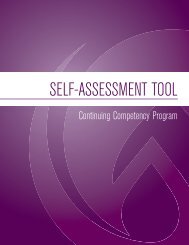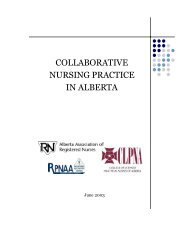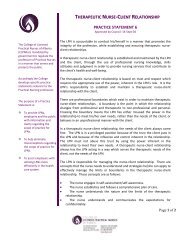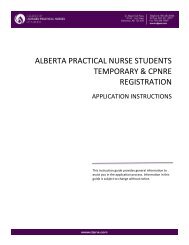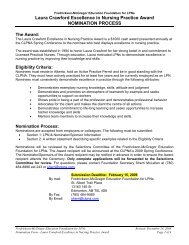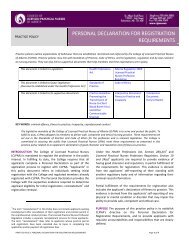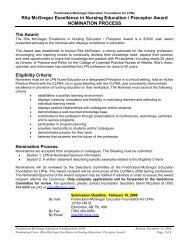Download PDF - College of Licensed Practical Nurses of Alberta
Download PDF - College of Licensed Practical Nurses of Alberta
Download PDF - College of Licensed Practical Nurses of Alberta
Create successful ePaper yourself
Turn your PDF publications into a flip-book with our unique Google optimized e-Paper software.
life & death mattersAnorexiaandCachexiaatEnd <strong>of</strong> LifeByKatherine Murray, BSN MA CHPCN(C)andJoshua Shadd, MD CCFPThis is the fourth in a series <strong>of</strong>articles about caring for thedying. Kath Murray, RN, is ahospice palliative care nursewith a passion for education.For further information andonline education, contact her atkath@lifeanddeathmatters.ca orsee www.lifeanddeathmatters.caJoshua Shadd, MD CCFP, isAssistant Pr<strong>of</strong>essor, Centre forStudies in Family Medicine,University <strong>of</strong> Western OntarioDepartment <strong>of</strong> Family Medicine.Jack, 84 years old, was admitted a monthago with declining condition, repeatedchest infections, frequent falls,progressive dementia and lung cancer.Since admission Jack is sleeping more,withdrawn, refusing food and has somedifficulty swallowing.Megan, Jack’s wife, visits daily, bringshomemade custard and encourages Jackto eat. Megan is concerned that if Jackdoes not eat he will die.Jack’s daughter Mary arrived today fromout <strong>of</strong> town. Alarmed by his weight loss,Mary promptly declared, “He is starving!”She believes that decreased nutritionalintake is responsible for his decliningcondition.Eating is a fundamental preoccupation <strong>of</strong>human beings. Food is a basic humanneed. Eating is an indicator <strong>of</strong> life andliving. Many social gatherings andcultural rituals revolve around food andeating as a way <strong>of</strong> “being together”.Feeding someone can communicate love.In light <strong>of</strong> all this, it is to be expected that“food” and “decreasing intake” willfrequently be the center <strong>of</strong> discussion,and sometimes the cause <strong>of</strong> contentionwithin families, between family and thehealth care team, and within the healthcare team in the last months/weeks/days<strong>of</strong> a person’s life. This article gives ideasfor discussing changing needs fornourishment and decreased intake.Need for nourishment changesIt is interesting to see a group <strong>of</strong> peopleeat at a restaurant or at a family reunion.We all require nourishment, but ourneeds change throughout life. The typeand quantity <strong>of</strong> food required to nourishand satisfy a twenty-five year old malewould cause a newborn to choke, and anolder adult to feel bloated or nauseated.Reflect on a time when you had the flu.How was your appetite affected? Wereyou able to eat full meals? How did youfeel if someone pressed you to eat?Statements like the “Simple TruthsAbout Nutrition” (below) remind us thatdeclining intake is a normal part <strong>of</strong>living-dying. Weaving these truths intoconversations about food and intakemay help to normalize the changes.What are anorexia and cachexia?Anorexia at end <strong>of</strong> life is defined as thedecreased interest in food and eating.Cachexia is defined as involuntaryweight loss (more than 5% <strong>of</strong> baseline)with a greater loss <strong>of</strong> muscle than fat.Cachexia is common in advanced cancerand some other severe progressiveillnesses.What causes cachexia?The body’s inflammatory response andtumors produce proteins that decreasemotility <strong>of</strong> the stomach and intestines aswell as increase muscle breakdown. Thisresults in reduced intake and acceleratedweight loss.Do anorexia and cachexiaoccur together?In palliative care, anorexia and cachexiausually occur together. People <strong>of</strong>tenassume that the anorexia (decreasedappetite) causes cachexia (involuntary>care | SUMMER 2011 29


